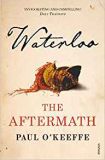Waterloo: The Aftermath by Paul O'Keeffe
| Waterloo: The Aftermath by Paul O'Keeffe | |
|
| |
| Category: History | |
| Reviewer: John Van der Kiste | |
| Summary: A slightly unusual approach to a well-chronicled theme, in that it examines what happened on the field of battle and throughout Europe during and after the battle of Waterloo | |
| Buy? Yes | Borrow? Yes |
| Pages: 392 | Date: April 2015 |
| Publisher: Vintage | |
| ISBN: 9780099563792 | |
|
| |
There have been several accounts of the battle of Waterloo and of the events that led up to it. But it is always interesting to discover a book which finds a different way of telling the tale, or in this case focusing more on what happened directly afterwards.
Strictly speaking, O'Keeffe really begins this volume with the thick of the fight itself, although eschewing the political and military build-up. We are plunged headlong into the nightmare chaos that was the field of battle, the sound of cannon fire and the screams of dying men and horses. There was another hardly more pleasant noise to be heard at the same time – that of hammers and chisels from the battlefield equivalent of the notorious grave robbers Burke and Hare, the opportunists who had travelled from England close to the armies and waited until the hostilities were over, in order to remove the teeth of dead soldiers and sell them to London dentists. They would be followed by members of the local population, who also swooped on the bodies for a similar reason. Deceased senior officers could be guaranteed to yield gold in their purses or valuable pocket watches for those who were lucky and shameless enough to get there first. There is one particularly harrowing description of a young mother carrying a baby with one hand as she removed a gold watch from a corpse's uniform with the other. As she stood up, a shell struck the sleeping child and severed its body completely in two. The woman was briefly knocked to the ground, as she glanced at the remains of her infant – and then, apparently unmoved, carried on plundering. Sightseers were eager to buy grisly souvenirs from the field of battle, so such scavengers evidently did not go unrewarded.
This is not a pretty story, and it does not get any prettier. The battle took place in midsummer, and within a few days the hot weather had made the stench of dead humans and animals almost unendurable. Not surprisingly, those who were responsible for burying them had all but given up. Some of them attempted to dispose of the bodies by burning them, which gave off an even worse smell. The ground was almost white in places from the volume of paper left lying around, be it playing cards, letters, pages from novels or prayer books, and even sheet music from bandsmen, all torn away and removed by the robbers who considered them useless.
If the battle was a miserable business for the vanquished, like the even more widespread European conflict of a hundred years later, it was only a little less so for the victors. The Duke of Wellington was said to have broken down and wept when told of the casualties among his friends had been killed, telling his doctor that he had never lost one, but now he knew how painful it was to win one. In his official dispatch, he called it a battle both won and lost. It had, he said, been a desperate action that had succeeded in every point, but that the loss had been immense. We are not given the French casualty figures, but it is recorded that 200,000 troops, 60,000 horses and over 500 guns were on the five square miles of the battlefield, and that the British, Prussian, Hanoverian and Dutch allies lost over 20,000 men between them. To some historians, the campaign which culminated in Waterloo was the first world war, the parent of the conflict of 1914-18.
It is perhaps with a sense of relief that we move away from the field itself. There are descriptions of how news of the fighting was received in London and in Paris, with rumours that Bonaparte had not merely abdicated and been arrested, but also assassinated. It soon became clear that this was a rumour too far, and that the still very much alive leader, having at last given up the quest to re-establish himself, became as much a tourist attraction as the place in Belgium which had ended his dreams of a return to his former glory. He was for a while kept on board ship off the coast of south Devon, pending his final exile on the distant island of St Helena. In a peculiar forerunner of the twentieth-century fascination with 'stars', many people were prepared to go on boats from harbour in order to catch a glimpse of the man who had been their greatest enemy, and even more strangely, to visit the laundry where his clothes and bed linen were being cleaned in order to try on or just touch the washed goods.
But the book is not all about post-Waterloo trivia. Much of the book focuses on the royalist restoration in France, and such matters as the restitution of art treasures which had been looted from other nations in order to make Paris the art capital of the continent, returning to their former homes, as well as the hunting down and execution of those who had been loyal to the Bonapartist cause. The details in general add up to a fearsome tale of a world turned upside down and slowly restored to its normal wellbeing, but a richly researched and magnificently detailed one.
For further reading, albeit with a more British focus, may we also recommend 1815: Regency Britain in the Year of Waterloo by Stephen Bates
Please share on: ![]() Facebook,
Facebook, ![]() Twitter and
Twitter and
![]() Instagram
Instagram
![]() You can read more book reviews or buy Waterloo: The Aftermath by Paul O'Keeffe at Amazon.co.uk Amazon currently charges £2.99 for standard delivery for orders under £20, over which delivery is free.
You can read more book reviews or buy Waterloo: The Aftermath by Paul O'Keeffe at Amazon.co.uk Amazon currently charges £2.99 for standard delivery for orders under £20, over which delivery is free.
![]() You can read more book reviews or buy Waterloo: The Aftermath by Paul O'Keeffe at Amazon.com.
You can read more book reviews or buy Waterloo: The Aftermath by Paul O'Keeffe at Amazon.com.
Comments
Like to comment on this review?
Just send us an email and we'll put the best up on the site.


